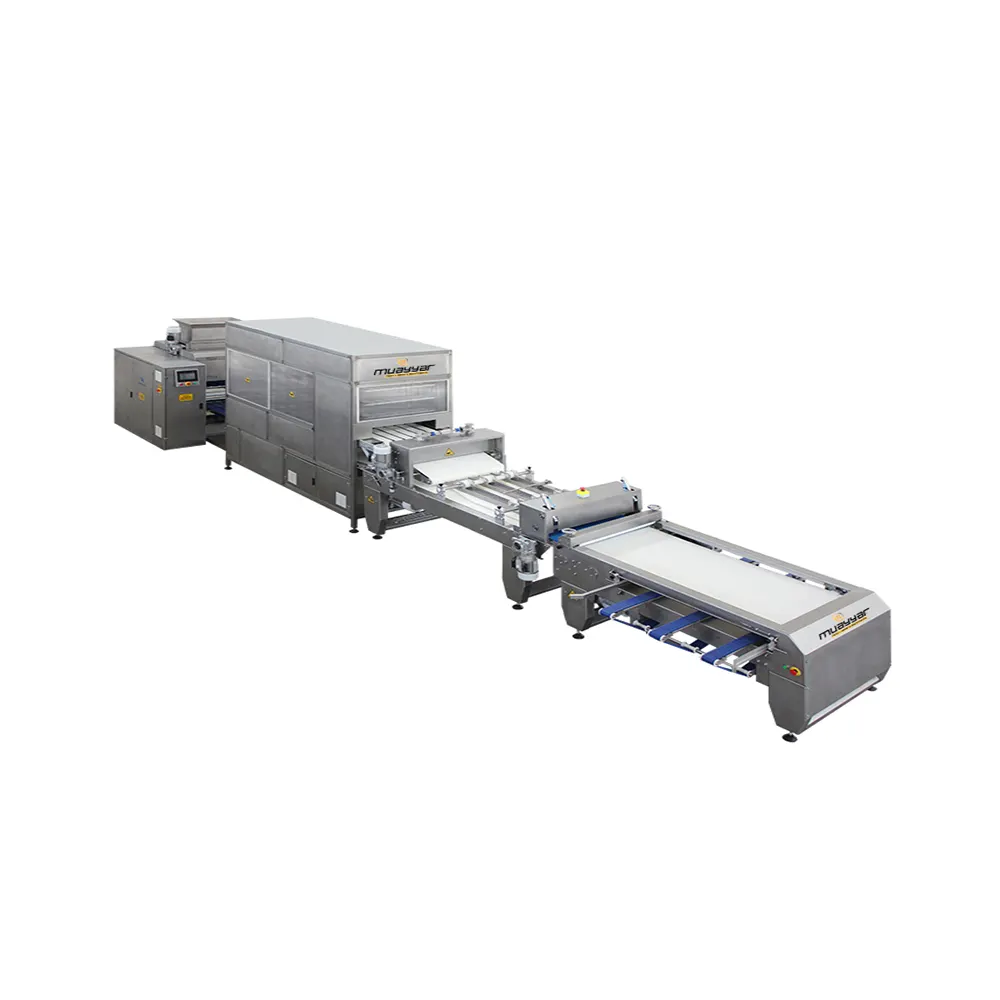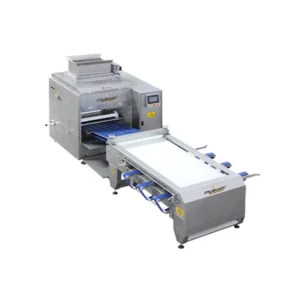Bread Roll Production Line
Technicial Specifications :
*** Line Capacity varies in direct proportion to the number of ovens. You can increase the capacity by increasing the number of ovens whenever you want.
| Line Content | HAMBURGER SANDWICH PRODUCTION LINE Dough Cutting and Rounding Machine Dough Vertical Type Proofing Machine Dough Forming Machine (Final Crushing is done by hand) Automatic Dough Arranging Robot |
| Capacities | Roll, Bun and Hamburger Bread Max 8000 Pieces / Hour (with 6 oven) Sandwich Bread 7000 Pieces / Hour (with 6 oven) |
| Control | PLC Display |
| Dough Cutting Range | 50-200 g |
| Conveyor Speed Control | Yes |
| Dough Cutting Ability | 6 Equal Weights of Dough at the same time |
| Dough Resting Unit | 516 bowls and 5 minutes of rest |
| Dough Forming Unit | 3 dough processing capacity at the same time |
| Suitable Tray Sizes | 50×74 – 59×80 – 60×90 – 75×104 – 80 x 104 |
| Available Types of Pans | Teflon-Aluminium or Special Coated Pans |
| Oil Consumption / Day | 1 Lt |
| Air Need | 6-8 Bar |
| Line Width-Length-Height (m) | 1.2*10*2.5 |
| Line Weight | 2.2 Tons |
| Electric power | 12 Kw |
| Voltage | 380 V 50-60 Hertz |
Maximizing Efficiency and Quality: The Technical Dynamics of Industrial Roll & Bun and Sandwich Production Lines
Introduction:
Industrial roll & bun and sandwich production lines are automatic systems designed to streamline the manufacturing process while maintaining high standards of quality and consistency. This comprehensive technical article explores the multifaceted components, advanced technologies, and operational process of these production lines.
1. Components of Industrial Roll & Bun and Sandwich Production Lines:
Dough Mixing Systems: Industrial mixers blend flour, water, yeast, and other ingredients to create dough.
Dividing and Rounding Machines: Divide dough into uniform portions and round them into balls for consistent sizing.
Proofer Chambers: Controlled environments for dough proofing, allowing for proper fermentation and texture development.
Sheeting or Moulder Machines: Shape dough into desired forms for rolls and buns, ensuring uniformity in size and shape.
Oven Systems: Bake dough pieces to perfection, achieving the desired texture, color, and flavor.
Packaging Machinery: Package finished products securely for distribution and retail.
2. Processes Involved:
Dough Preparation: Mixing, dividing, and rounding processes to create uniform dough portions.
Proofing: Controlled fermentation to develop flavor, texture, and volume in the dough.
Shaping and Moulding: Forming dough into specific shapes and sizes for rolls and buns.
Baking: Uniform baking of dough pieces in ovens to achieve desired characteristics.
Filling and Assembly: Precise assembly of sandwiches with fillings and toppings according to recipes.
Packaging: Secure and hygienic packaging of finished products for distribution and sale.
3. Advanced Technologies and Innovations:
Automated Control Systems: Computerized systems monitor and regulate various parameters such as temperature, humidity, and baking times for consistent results.
Automation: Robotic arms and machinery streamline production processes, increasing efficiency and reducing labor costs.
Multi-Functionality: Versatile equipment capable of handling a wide range of dough types, fillings, and toppings for diverse product offerings.
Hygienic Design: Stainless steel construction and modular designs ensure easy cleaning and maintenance, meeting strict food safety standards.
Customization Options: Flexible configurations and modular designs allow for easy adaptation to changing production needs and product variations.
4. Efficiency and Throughput:
High-Speed Production: Industrial production lines can produce thousands of rolls, buns, and sandwiches per hour, meeting the demands of large-scale food manufacturing operations.
Continuous Operation: Seamless integration of various components and processes enables continuous production with minimal downtime, maximizing efficiency and throughput.
5. Quality Control and Assurance:
Quality Inspection Systems: Automated inspection systems detect and remove defective products, ensuring consistent quality and adherence to specifications.
Traceability: Tracking systems record production data and ingredient sources, facilitating traceability and quality control measures.
Industrial roll & bun and sandwich production lines exemplify the convergence of advanced technology, precision engineering, and operational excellence. By leveraging sophisticated equipment, automation, and quality control measures, food manufacturers can optimize production efficiency, ensure food safety, and deliver high-quality products to consumers worldwide.




Reviews
There are no reviews yet.